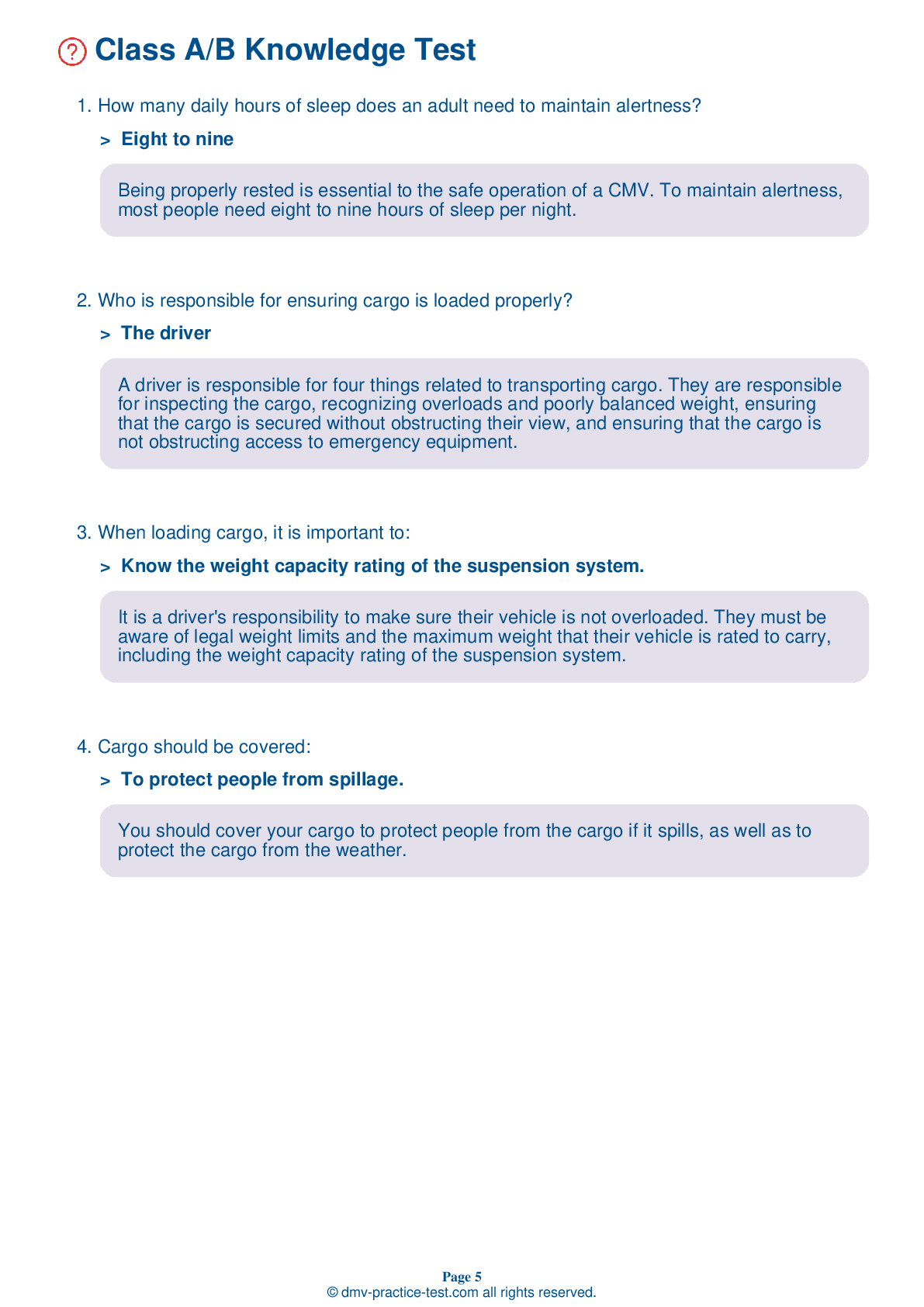Air Brakes #2
Air Brakes Endorsement Test | District Of Columbia 2025 #2 Page 2 of 4
Train for FREE online with our District Of Columbia CDL air brake test. The official exam test consists of several obligatory parts, with all of them checking your knowledge of different blocks of road rules. If you need to obtain a DC Class A/Class B driver license in 2025, practice as much as possible. Free sample tests published on our website will help you check and improve your knowledge and boost your grades. Please bear in mind that the requirements for CDL may vary from state to state.
25
20
20
7 . To use the stab braking method, you should:
Apply the emergency brake until the vehicle starts to slow.
The stab braking method for emergency stops involves fully applying the brakes until they lock up. The brakes are then released until the wheels start rolling, and then the process is repeated.
8 . What should happen if the air pressure in the braking system's air tanks falls below 60 psi?
The steering wheel will lock up.
On vehicles with air brakes, a low air pressure warning signal will come on if the pressure in the air tanks falls below 60 psi. On large buses, the signal may activate at 80 to 85 psi.
9 . Emergency brakes are:
Only required when transporting hazardous materials.
All trucks, truck tractors, and buses must be equipped with emergency brakes and parking brakes.
10 . A low air pressure warning signal should activate:
When tank pressure falls below 5 psi.
In an air brake system, a low air pressure warning signal must come on if air pressure in the tanks falls below 60 psi. This warning signal may come in the form of a light, a buzzer, or a wig wag.
11 . If braking at a speed of 55 mph while driving on dry pavement, the brake lag can add ____ to your vehicle's total stopping distance.
10 feet
The total stopping distance for vehicles equipped with air brakes is made up of four factors: perception distance, reaction distance, brake lag distance, and braking distance. When braking at a speed of 55 mph while driving on dry pavement, the brake lag can add around 32 feet to a vehicle's total stopping distance.
12 . Brakes may get out of adjustment:
If they get wet.
Brakes can get out of adjustment quickly, especially if they are used to the point of overheating. Brake adjustment should be checked frequently.
2025 District Of Columbia | Frequently Asked Questions
To acquire a CDL Hazmat endorsement in the District of Columbia, you must first hold a valid CDL. Then, pass the Hazardous Materials Knowledge Test at a DMV service location. You'll also need to undergo a federal TSA background check and fingerprinting. Lastly, submit the Hazmat Endorsement Application, proof of U.S. citizenship or legal status, and pay the required fees.
To obtain a CDL Hazmat license, you must already hold a valid Commercial Driver's License (CDL). You also need to pass the Hazardous Materials Knowledge Test, undergo a federal TSA background check, and be fingerprinted. Proof of U.S. citizenship or legal status is required. Lastly, you need to be in good physical health to meet the demands of the job.
When applying for a CDL Hazmat endorsement, you'll need to provide your valid Commercial Driver's License (CDL), proof of U.S. citizenship or legal residency (like a passport or birth certificate), and proof of identity. You'll also need to bring the receipt for your TSA background check and fingerprinting, and complete the Hazmat Endowment Application.
Yes, there is a dedicated written test for the CDL Hazmat endorsement. This test focuses on the rules and safety procedures for handling and transporting hazardous materials. It's essential to study the Hazmat section of your state's CDL manual thoroughly before taking the test to ensure you're well-prepared.
The written test for the CDL Hazmat endorsement covers a range of topics related to hazardous materials. These include identifying hazardous materials, understanding shipping papers, using placards and labels, handling emergencies, loading and unloading procedures, and complying with the relevant safety rules and regulations.
Yes, there are extra charges associated with acquiring a CDL Hazmat endorsement. These include fees for the TSA background check and fingerprinting, which typically cost around $86.50. Additionally, there may be a fee for the endorsement application, which varies by state. It's best to check with your local DMV for specific costs.
Yes, obtaining a CDL Hazmat endorsement requires a mandatory background check and fingerprinting conducted by the Transportation Security Administration (TSA). This ensures the individual doesn't pose a security threat and is part of the federal safety regulations for handling hazardous materials.
Yes, specialized training is mandatory for the CDL Hazmat endorsement. Applicants must pass a written test that covers the regulations and requirements for transporting hazardous materials. After passing the test, they receive a certification, which is the Hazmat endorsement on their Commercial Driver's License (CDL). This ensures they are knowledgeable about handling hazardous materials safely.
No, you cannot legally transport hazardous materials without a valid CDL Hazmat endorsement. This endorsement ensures that you have the necessary knowledge and skills to handle hazardous materials safely. Driving without it can result in serious penalties, including fines and suspension of your commercial driver's license.
Yes, you can add a Hazmat endorsement to your existing CDL. You don't need to apply for a new CDL. However, you must pass a written Hazmat knowledge test, submit to a TSA background check, and pay the associated fees. Once these steps are completed successfully, the Hazmat endorsement will be added to your CDL.



